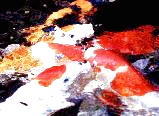|
Buying the Right Koi
by Elmer Epistola
Posted: October 11, 2004
Raising a good koi costs as
much as raising a bad koi, so why buy the latter? Well, not
everyone can afford a Momotaro Kohaku, so I guess we all agree that
the purchase cost of the koi itself more or less sets the
acquisition's upper limit. What, then, sets the lower limit,
if there really is one? In my opinion, the lower limit should
be set by the quality of koi in the store - don't buy something that
you won't like in your pond someday, no matter how cheap it is.
I know the feeling of coming
home empty-handed, after waiting for the weekend to arrive just so
you can add another fish to your pond. If what greets
you in the store are emaciated, dull-colored koi, then you should
resist the temptation of buying. Chances are you won't like them
swimming with your prized Showas a couple of years down the road.
As they all say, build up your koi collection s-l-o-w-l-y.
Not all inexpensive koi are
bad, you just have to know which ones to buy. I've been able
to acquire island-born koi in the past that are a fraction of the
cost of Japan-import ones, yet you can't tell them apart once they
swim side by side in the pond. In fact, I've also seen koi
that were imported from Japan that simply don't live up to
expectations, by a wide margin at that. When it comes to
hobby-grade koi, it's all in the genes, not where they were born.
So what must one look for when
buying a koi? I looked at what koi experts had to say in
various articles, and collated the most frequently given tips, so here they are...
1) Don't buy a koi that
doesn't look healthy. A lot of them are easy to spot - hanging
upside down or at weird angles in the water, has one or more sores
anywhere on its head, body, tail, or fins, swimming erratically,
gasping for air, lethargic and possibly in self-isolation.
Some may be a bit in the gray area of what's healthy or not -
swimming normally but lacking in appetite (which you can observe at
feeding time), exhibiting dull skin color, or taking occasional rests
with clamped fins. These are all sick koi that must be
avoided. In fact, don't bother buying any koi that shares the
same tank with them! For more symptoms of diseases, please see the
page
Koi Diseases.

Figure 1. Healthy koi have
voracious appetites. Don't buy
a koi that doesn't join the frenzy at
feeding time.
2) Don't buy a koi with
deformities. Deformities are there and they're there to stay.
Don't fool yourself into believing that you're just imagining them.
If something doesn't look right, then something's not right.
Crooked spine, missing fins, short body, gigantic fins, large head,
split fins, parrot head, smashed mouth, elongated nose, flat back,
gills that don't close flat: they're but some of the deformities
you'll have to look out for. Most stores that I've gone
to in the country have them to varying degrees, so be careful.
3) Don't buy a koi with
parasites anywhere on its head, body, and fins. Do we really
still need to discuss this? Unless you're really getting a huge and
once-in-a-lifetime bargain
and
you have a quarantine tank
and
you have the expertise to deal with parasites, don't ever think for
one second that you can simply kill the parasites when you get home.
You'll end up exposing your healthy koi to these pesky
microorganisms, and shelling out hundreds of dollars to bring them
back to the way they were.
Believe me - I've been there,
done that. I saw this beautiful nidan Kohaku with great skin,
color, and pattern that's being sold for only a hundred pesos ($2).
The only problem was, it shared the same tank with koi that clearly
had fish lice on their body. And wasn't there a dark green
spot on its head when I bought it? In a couple of weeks' time
all the healthy fish in my pond had the same green spots on their
heads. I committed two novice mistakes in this situation - I
bought infested fish and I didn't quarantine them. Again, I
recommend the page
Koi Diseases if you want to know more about
parasites.
4) Buy only koi with a
good body shape. Koi body is something that novice hobbyists
tend to ignore in the selection of their first koi. There are
some valid explanations for this: a) they are often not aware that
body conformation is such an important aspect of koi appreciation;
b) they don't know what a 'good' body is; and c) they easily get
more attracted to color. If you're still planning to buy your
first koi, don't do so until you are familiar with what
the ideal koi body
is.
I myself hadn't listened to
this advice when I got my first koi, which I regretted so much when
the koi reached 16 inches in length at age 3. The bright
colors of the poorly-bodied koi were not enough to make up for the
distracting eel-like appearance of the koi. On the other hand,
the less colorful but well-built koi in my pond have a commanding
presence whenever they swim by. So always remember the basic tip:
buy koi that are broad at the shoulders and torpedo-like in shape.
Continue to next page...
HOME
|

